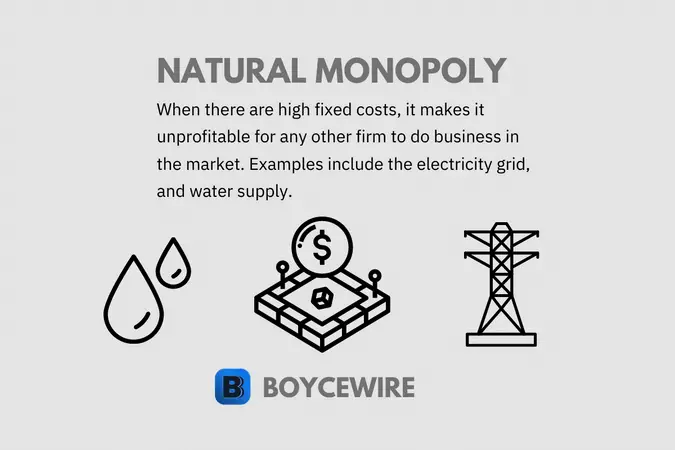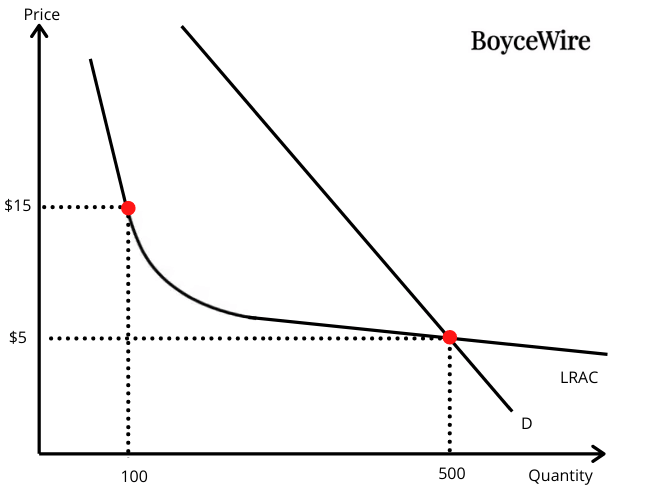Natural Monopoly: Definition, Characteristics & Examples

What is a Natural Monopoly
A natural monopoly is a type of monopoly that occurs due to high fixed costs and a need to achieve extreme economies of scale. In other words, it is only economically viable for one business to serve the market. Examples include the likes of utilities and train lines. The infrastructural costs are so high that two companies competing in the market would make it completely unprofitable for the other.
To explain, a company with a natural monopoly is the only firm in the market. It is able to obtain this position through high fixed costs, geographical location, technological expertise, and other barriers to entry. These are defined as ‘natural’ in the fact that there is no government involvement that alters the ‘natural’ state of the market.
If we look at the energy grid for example – there are a lot of fixed costs involved. There is a sophisticated network that transfers electricity from power plants to individual homes. If another company was to set that up, it would cost billions. On top of that, it would cost even more to maintain it. It is for that reason that it is more economically effective to have one supplier – another competitor just wouldn’t be able to make back the initial investment.
Key Points
- Where there is a natural monopoly, it is more efficient for there to be only one company in the market.
- Natural monopolies are characterised by long tail economies of scale that aren’t achieved until the vast majority of the market is serviced.
- A firm with a natural monopoly will usually have high fixed costs.
As natural monopolies are largely unavoidable, many people advocate for government control over such markets. So instead of a private monopoly, it would be a public monopoly. This is in order to prevent private entities from overcharging and taking advantage of the consumer.
This potential solution to natural monopolies is very sensible. However, this would assume that natural monopolies exist permanently – which they do not. If they start charging higher prices, it makes alternatives cheaper. For example, the business that controls the supply of oil may increase prices. This in turn opens the door for alternative solutions, such as solar panels, Microhydropower, Geothermal, or Residential Wind Power. Yet by government controlling these forces, it deprives the alternatives from becoming economically viable.
Natural Monopoly and Economies of Scale
Natural monopolies exist primarily because economies of scale, which are so crucial. In other words, the firm needs to be able to serve all of the market in order for it to remain financially viable. By doing so, it is able to gain from economies of scale and reduce the average unit price.
This is predominantly an issue in markets whereby there are high fixed costs. For example, energy grids have extraordinary setup costs, with additional costs to maintain the system. Once these are set up, the cost to serve another customer is relatively low – meaning the more customers it serves, the more income to receives to pay for those initial costs.
Natural Monopoly Characteristics
Some of the common characteristics of a natural monopoly include:
1. Naturally Occurring
One of the most important aspects of a natural monopoly is that it is natural. But what does that mean? It simply means that through the free market, competitors are unable or unwilling to compete. In other words, there are no external forces such as government regulations or protections that prevent competition.
Natural monopolies are naturally occurring in the fact that there are economical forces that prevent more than one company from entering the market. These natural elements mainly surround two factors – large fixed costs, and long economies of scale. Both are naturally occurring in specific markets such as the energy grid, sewerage systems, and water supply.
The firm needs to be able to serve the whole market in order to obtain economies of scale which would be necessary in order to develop demand for the good. For instance, airlines need to serve a large population in order to justify the high fixed costs on the planes it purchases.
2. Large Fixed Costs
A natural monopoly has extraordinarily large fixed costs. For instance, sewerage systems have significant initial fixed costs, but also require regular maintenance. If we say that those initial fixed costs were $10 billion, it means that it needs to make that much money back in order to make it economically viable.
If two companies enter, there will be a total of $20 billion in initial fixed costs to create two sewer networks. That means the two firms need to now recoup double the investment to make it economically viable.
To explain, even if the company sells to everyone in the market, it only just covers its fixed costs. That is to say that those fixed costs are so large that without the whole market, it would go out of business.
3. Low Marginal Costs
Natural Monopolies are characterized by high fixed costs, but low, if any, marginal costs. That means it costs very little to serve one extra customer – meaning economies of scale are crucial to such firms.
If we look at airlines, for instance, there are cases whereby only one airline can service a specific route. This might be because it is remote or there is low demand for that destination. To operate that route, the airline has high fixed costs in terms of the plane, maintenance, and staff. However, the cost to fly one customer versus 100 is virtually zero. So the more people the airline has on the plane, the more economically viable that route is.
4. Long Economies of Scale
Economies of scale is a crucial aspect of a natural monopoly. This is because only one firm can truly benefit from economies of scale in a market that is a natural monopoly.
In economics, we refer to this as ‘long-tail economies of scale’. Essentially, long-run average costs continue to fall until the vast majority of the market is serviced. So economies of scale are not fully achieved until demand is met. In other words, when a firm services 80 percent of the market, it may cost $5 to produce good A. However, at 100 percent of the market, it may only cost $4 to produce it. At the same time, there is only demand for the product when the product is produced and sold at a lower value.
5. Competition is Undesirable
In a natural monopoly, the point by which a company benefits from economies of scale is close to the whole demand in the market. That means that before this point, economic production is inefficient because the average cost of producing the good or service is higher than it would be otherwise.
To explain, let us take an example. Suppose you have two planes; each can carry 100 passengers – meaning there are a total of 200 seats. Both are flying from San Francisco to North Korea. However, only 100 people want to go. Split across the two providers, they are left at 50 percent capacity. In turn, the cost is significantly higher than if there was only one provider – meaning it would be more economically efficient and desirable to have one provider.
Natural Monopoly Examples
There are many examples of natural monopoly in the real world. Some examples include:

Airlines
Most airlines are in a competitive market, offering customers a number of options. However, in low demand routes, such as Sudan to New York, it is only profitable for one firm to service the market. This is because a half-full plane represents an effective loss to most airlines.
It may cost $5,000 to travel 100 people from Destination A to Destination Z. However, if there are two planes, the cost will be double as there are a number of fixed costs. So those costs exist whether it serves 1 person or 100 – and in this industry, there are only small marginal costs to serve the additional customers.
In short, the total cost to fly two planes would be $10,000. Yet the demand is still 100, which won’t even fill up one plane. It would just be economically inefficient to run two half-empty planes – unless the price charged was significantly higher, but that would reduce demand.
Energy Grid
Most countries across the world have a single firm that controls the energy grid – although these are usually highly regulated. The reason this is a natural monopoly is because the cost to set up a new network to link the energy supply to each household would cost billions.
In addition, we have the fact that it becomes economically wasteful not only to have two lines but also the cost associated with its maintenance. Another firm could theoretically enter the market, but it would take decades to break even. On top of that, it would significantly increase the average cost – meaning higher prices to the customer.
Local Bus Routes
Some small towns have bus routes that only serve perhaps one hundred people a day. Any firm servicing that market would have the fixed costs of a bus, driver, and fuel. Considering the small size of demand, the bus would never be full at any point in time.
It would be economically inefficient for two buses to go round at the same time in order to pick up one customer each. Instead, a natural monopoly exists because of this very factor. It wouldn’t be economically viable unless customers were charged prices in excess of $100 a trip. However, no customer would pay that, which is why one single firm is desirable.
Operating Systems
Windows is by far the most dominant operating system in the market. We could define this as a natural monopoly, although other systems such as Apple and Linux have bridged the gap in recent years. The main barrier was the fact that files saved on Windows could not be used on an Apple Mac.
Not only in the workplace, but in general use, the transfer of incompatible files was a huge barrier to entry. It was quite simply more efficient and effective to use one system. This efficiency extended beyond financial reasoning, but more towards the ease of use and practicality. Naturally, people would rather have an operating system that is in mainstream use where files can easily be transferred. In turn, we can identify long economies of scale, whereby it becomes more efficient for the customer to use one product.
With that said, operating systems now have the compatibility to share and read files from other systems. In part, this is because the initial technological barrier (file sharing) has been overcome by the market.
Rail Network
To travel from Station A to Station B, a rail-line is required. That rail-line needs to be constructed and maintained in the years after. If two firms were to enter the market, those costs would be duplicated. Now we might say, well what is different from other industries? The difference is the fact that not only are the fixed costs high, but thousands and millions of customers need to pay for the service in order for it to be economically viable.
If there were two companies with a similar market share, the average cost to them would be double that of a single company. This is because the marginal cost is low – meaning there is little cost to serve an extra customer.
Natural Monopoly Graph
If we look at a simple natural monopoly graph, we see long-run average costs (LRAC) falling steadily. When this intersects with the demand curve, we have the optimal level of production in society.
When there are three competitors in the market, quantity is at 100 and the long run average cost is $15. However, when there is one competitor in the market, we are left at the equilibrium point at $5. At this point, economic output is the most efficient as demand is met at the lowest possible price.

Natural Monopoly FAQs
A natural monopoly is a type of monopoly whereby it is only economically viable if there is only one player in the market. In other words, if there was more than one firm competing, both would make losses because it is unaffordable to compete due to costs of production.
The energy grid is an example of a natural monopoly. It has exceptionally high fixed costs – imagine setting up a new mast system that spans from the energy plants to each house. At the same time, it is far more efficient for one firm to provide the whole of the market. To spend billions on new masts and other infrastructure, as well as the continuous maintenance – it would almost double the cost to the consumer.
The main characteristics of a natural monopoly are:
1. Naturally Occurring
2. Large Fixed Costs
3. Low Marginal Costs
4. Long Economies of Scale
5. Competition is Undesirable
The difference between a monopoly and a natural monopoly is the fact that natural monopolies have extreme economies of scale. That is to say that it can only start to become profitable when one single firm is able to service the majority of the market.
Amazon is not a natural monopoly. Although it dominates the e-commerce market, there are many other alternatives out there that are able to conduct a profitable business. The main reason being is that the fixed costs to enter the market are not that significant to create an extreme need for economies of scale.
About Paul
Paul Boyce is an economics editor with over 10 years experience in the industry. Currently working as a consultant within the financial services sector, Paul is the CEO and chief editor of BoyceWire. He has written publications for FEE, the Mises Institute, and many others.

Further Reading
 The Consequences of the Industrial Revolution - The consequences of the industrial revolution were far-reaching and included technological innovation, urbanization, labor exploitation, environmental degradation, social changes, and…
The Consequences of the Industrial Revolution - The consequences of the industrial revolution were far-reaching and included technological innovation, urbanization, labor exploitation, environmental degradation, social changes, and…  Capital Flight: Definition, Causes, Effects & Examples - Capital flight occurs when investors or businesses remove their money from a country.
Capital Flight: Definition, Causes, Effects & Examples - Capital flight occurs when investors or businesses remove their money from a country.  Central Limit Theorem - The central limit theorem states that as the sample size increases, the sampling distribution of the sample mean approaches a…
Central Limit Theorem - The central limit theorem states that as the sample size increases, the sampling distribution of the sample mean approaches a… 